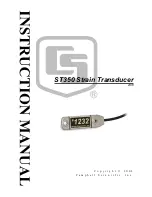
Section 3. Sensor Alignment and Installation
3.3 Adjusting Excessive Transducer Offset
If it is determined that zeroing cannot be accomplished with the Wheatstone
Bridge circuit, then it is possible that the transducer has either been damaged or
deformed slightly. In many cases the deformation is caused by a thermal
change in the gage due to weather changes, such as location of the sun. In this
case, the offset can be adjusted by simply loosening one nut and allowing it to
return to a “zero-stress” state. Once the nut is loose, rebalance the bridge and
ensure the gage can be zeroed. Retighten the nut and again, rebalance and
ensure the gage is zeroed. If the transducer still cannot be zeroed, ensure that
the mounting surface is flat. In many mounting situations, especially on timber
and aged concrete, additional surface preparation will need to be performed to
obtain a flat mounting surface. If it has been determined neither of the above
are causing the excessive offset proceed with the following steps:
1.
Determine which direction the offset is in.
2.
If the gage is too far in compression, loosen the free end of the gage (the
end opposite of where the cable exits).
Sensor is in compliance if the offset is within ±2.1 mV/V
excitation (approximately 1000 microstrain).
NOTE
3.
Pull on this end of the transducer gently and re-tighten the nut or C-clamp.
4.
If enough force cannot be applied with the gage attached to the structure,
remove the gage and pull it from both ends. Hopefully, while watching
the gage in “Monitor” mode, the gage will come closer to zero.
5.
If the offset is in the opposite direction (i.e. too far offset in tension)
perform steps two through four, except push on the transducer rather than
pull.
If this initial offset cannot be removed, please return the transducer to BDI for
evaluation.
Remember!
The transducers are high-quality, precision sensors and are
therefore quite sensitive, so be very careful while handling them!
3-3
Summary of Contents for ST350
Page 6: ...Section 1 Introduction 1 2...
Page 8: ...Section 2 Specifications 2 2...
Page 12: ...Section 3 Sensor Alignment and Installation 3 4...
Page 22: ...Section 5 Mounting of Sensor to Various Surfaces 5 8...
Page 24: ...Section 6 Calibration and Validation 6 2...
Page 28: ...Section 7 Maintenance Replacement Parts and Repairs 7 4...
Page 32: ...Section 8 Datalogger Programming 8 4...
Page 44: ...Appendix B ST350 Accuracy Verification B 6...
Page 49: ...This is a blank page...












































